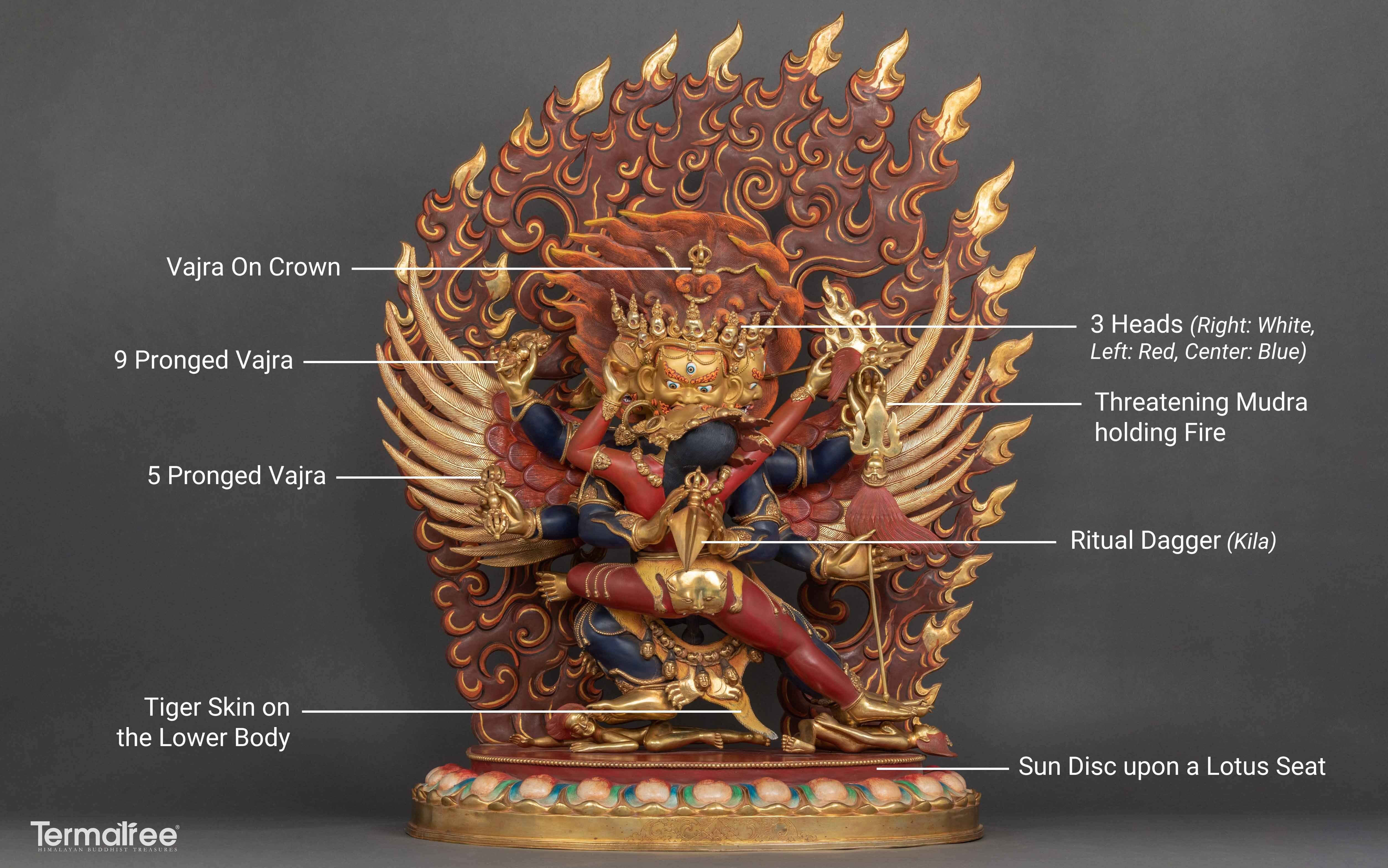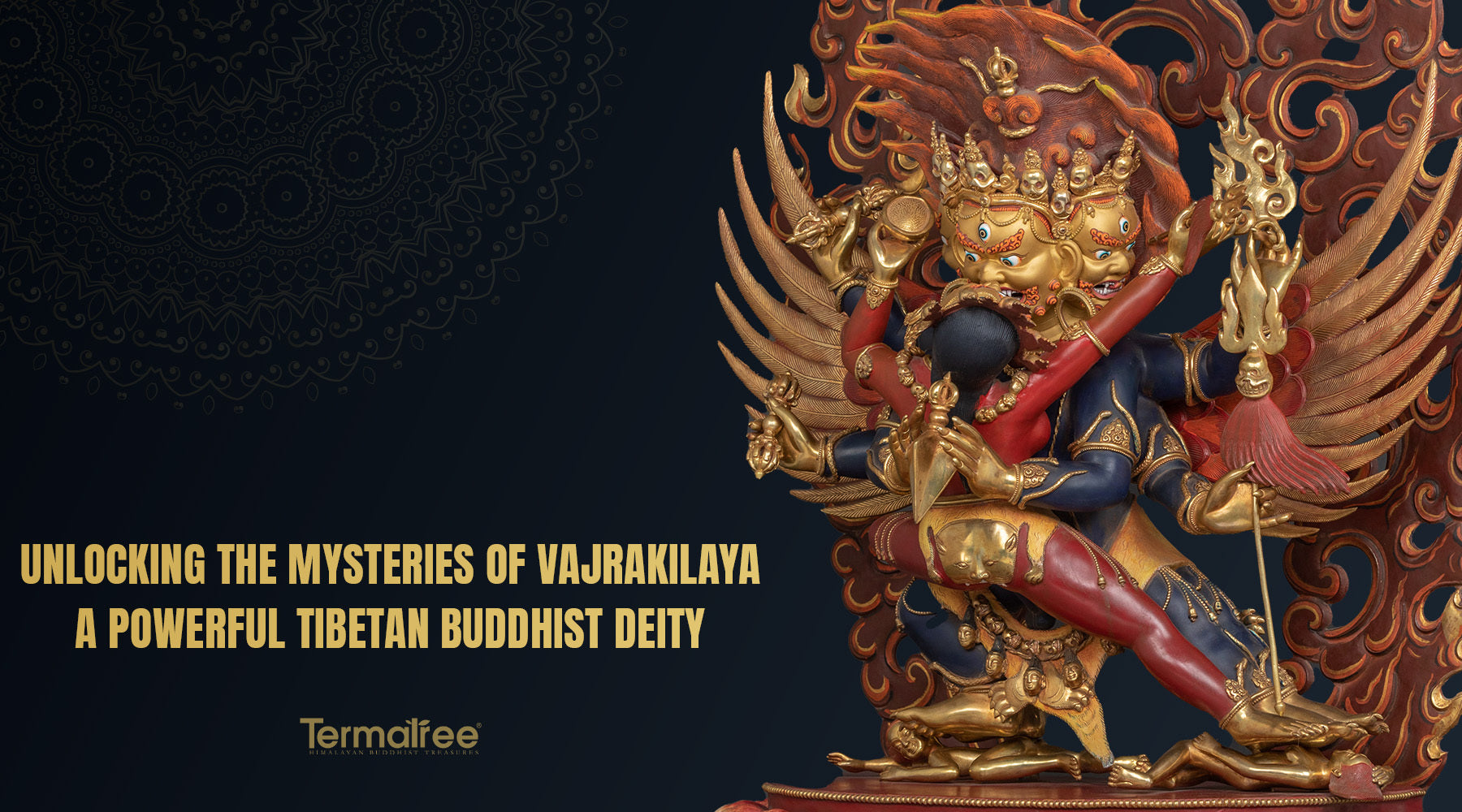Harnessing Vajrakilaya's Energy for Healing
Vajrakilaya, a potent and enigmatic deity in Tibetan Buddhism, translates to "the Vajra that Destroys Negativity." This wrathful deity is significant among Tibetan Buddhist gods and goddesses due to its unique attributes and transformative power. In this article, we will explore the mysteries surrounding Vajrakilaya, including its origin, symbolism, practice, rituals, and enduring significance in the modern world.
Key Takeaways
- Vajrakilaya is a prominent deity in Tibetan Buddhism, known for its wrathful appearance and protective qualities.
- This deity is associated with purification and removing obstacles on the spiritual path.
- The Vajrakilaya practice involves rituals, mantras, and visualization techniques.
- Understanding the symbolism of Vajrakilaya is crucial for practitioners to connect with its energy.
- In modern times, Vajrakilaya continues to be an integral part of Tibetan Buddhist traditions.
The Origin of Vajrakilaya
Originating within the Vajrayana tradition of Tibetan Buddhism, Vajrakilaya is believed to manifest the compassion of the Buddha, specifically emerging from the wisdom aspect of Padmasambhava, a revered figure in Tibetan Buddhism.
Padmasambhava, commonly known as Guru Rinpoche, is renowned for bringing Buddhism to Tibet during the 8th century CE. He played a crucial role in disseminating the Dharma and pacifying the hostile forces and deities in Tibet. Vajrakilaya, an emanation of Padmasambhava, represents the fierce facet of his compassion, with the mission of overcoming spiritual impediments and opposing forces.
The Symbolism of Vajrakilaya

Click here to view our Vajrakilaya Statue
To truly appreciate Vajrakilaya's significance in Tibetan Buddhism, it's crucial to delve into its symbolism. This deity's form is a captivating blend of awe and dread, often depicted with multiple arms and heads, clutching a vajra (thunderbolt) and a phurba (ritual dagger). Here are key aspects of Vajrakilaya's symbolism:
-
Wrathful Visage
Vajrakilaya's wrathful appearance serves a dual purpose. On one hand, it symbolizes the intense determination to obliterate negativity and obstacles. On the other, it mirrors the deity's compassionate intent to free beings from suffering by eliminating the root causes of their afflictions. -
The Three Faces
Vajrakilaya is commonly depicted with three faces, each carrying profound symbolism. The central wrathful face signifies the eradication of ignorance, the left face embodies compassion, and the right face symbolizes wisdom. This triadic aspect underscores the interconnected nature of these virtues on the path to enlightenment. -
The Multiple Arms and Implements
Vajrakilaya's multiple arms and held implements symbolize its capacity to engage in multifaceted actions for the welfare of sentient beings. The vajra, clutched in one hand, represents the unyielding nature of wisdom, while the phurba, held in another, signifies the piercing strength of compassion. -
The Vajra Family
In Tibetan Buddhism, deities are often classified into five Buddha families, each associated with specific qualities. Vajrakilaya belongs to the Vajra family, denoting invincibility, fearlessness, and the power to transform negativity.
The Practice of Vajrakilaya
Vajrakilaya practice holds a central place in Tibetan Buddhism, particularly within the Vajrayana or Tantric tradition. This practice focuses on purification and eliminating external and internal obstacles encountered on the journey to enlightenment. Here's a concise overview of the essential components of Vajrakilaya practice:
-
Visualization
At the core of Vajrakilaya's practice lies an intricate and detailed visualization of the deity. Practitioners imagine themselves as Vajrakilaya, embodying the deity's qualities and compassionate fierceness. This visualization serves to purify one's negativities and obstacles.
-
Mantra Recitation
Mantras hold a significant role in Vajrakilaya practice, with the most renowned being the Vajrakilaya Mantra, chanted repetitively during the practice. The resonance of the mantra is believed to cut through negativity and cleanse the mind.
-
Ritual Implements
Vajrakilaya practice frequently incorporates ritual implements such as the phurba (ritual dagger) and vajra (thunderbolt). These tools are symbolically employed to pierce through obstacles and negativity.
-
Guru Yoga
Many Vajrakilaya practices include Guru Yoga, where practitioners envision their spiritual teacher as an embodiment of Padmasambhava, transmitting the blessings and wisdom of the lineage.
-
Mandala Offering
As part of the practice, practitioners often make mandala offerings, symbolizing the offering of the entire universe as an act of devotion and surrender to the deity.
Vajrakilaya Rituals and Mantras
Rituals associated with Vajrakilaya are diverse, varying across Tibetan Buddhist traditions and schools. However, the fundamental components generally focus on purification and obstacle removal. Here's a simplified overview of a typical Vajrakilaya ritual:
Cleansing and Purification: The practitioner initiates the process by cleansing and purifying themselves both physically and mentally.
Creating a Sacred Space: A ritual space is meticulously arranged with offerings and necessary implements.
Invoking Vajrakilaya: The practitioner calls upon Vajrakilaya's presence through visualization, mantra recitation, and deep concentration.
Visualization: The practitioner envisions themselves as Vajrakilaya, with the deity at the core of their being.
Mantra Recitation: The Vajrakilaya Mantra is chanted, often with a specific number of repetitions.
Offerings: Devotional offerings are presented to the deity, symbolizing the practitioner's generosity and devotion.
Dissolution: The practitioner dissolves the visualization, merging the self with the enlightened qualities of the deity.
Dedication of Merit: The merit accumulated during the practice is dedicated to benefit all sentient beings.
The specifics of Vajrakilaya rituals can be highly elaborate, especially in advanced practices, and may require guidance from a qualified teacher.
The Significance of Vajrakilaya
Vajrakilaya holds profound significance in Tibetan Buddhism for several compelling reasons:
-
Purification of Negativities
The core objective of Vajrakilaya's practice lies in purifying negativities and eliminating obstacles. In the Vajrayana tradition, these hindrances are perceived as barriers to achieving enlightenment. Vajrakilaya, with its wrathful compassion, is considered a potent method for their removal. -
Transformation of Negative Energies
Vajrakilaya doesn't merely obliterate negativity; it transmutes it into positive energy. This transformation embodies a fundamental principle of Tantric Buddhism, where everyday experiences and emotions serve as a path to awakening. -
Protective Deity
Vajrakilaya is frequently invoked as a protective deity, guarding against external and internal threats. Its formidable appearance and powerful presence are believed to ward off evil forces and negative influences. -
Compassionate Enlightenment
Vajrakilaya epitomizes the fusion of compassion and wisdom, illustrating the inseparability of these qualities on the journey to enlightenment.
The deity's wrathful form serves as a poignant reminder to practitioners of the urgency to dispel ignorance and suffering while nurturing compassion and wisdom.
Vajrakilaya in Modern Times
In contemporary Tibetan Buddhist practice, Vajrakilaya maintains its pivotal role and reverence. Its teachings and practices are perpetuated by qualified instructors, ensuring the preservation of this profound tradition. Here's how Vajrakilaya remains relevant in the modern context:
-
Spiritual transformation
In a world brimming with distractions and challenges, Vajrakilaya's practice offers a path to spiritual transformation. Many individuals turn to Vajrakilaya to navigate the complexities of modern life, fostering inner peace and wisdom. -
Healing and Protection
The protective attributes of Vajrakilaya are sought by those facing personal or external challenges. The deity is often invoked to provide healing and protection to those in need. -
Preservation of Tradition
Tibetan Buddhist monastic institutions and lineage holders diligently safeguard Vajrakilaya rituals and teachings. This ensures that future generations can access and benefit from this profound wisdom. -
Global Reach
As Tibetan Buddhism spreads to the West and beyond, Vajrakilaya's practice has gained an international following. It transcends Tibetan communities, resonating with individuals from diverse cultural backgrounds who seek spiritual growth.
In the intricate tapestry of Tibetan Buddhism, Vajrakilaya shines as a symbol of wrathful compassion and transformative power. Its fierce appearance and profound symbolism embody the core principles of the Vajrayana tradition, offering practitioners a means to purify negativities, remove obstacles, and awaken their innate wisdom and compassion.
As Vajrakilaya continues to be revered and practiced in modern times, it stands as a testament to the enduring relevance of Tibetan Buddhist wisdom in our ever-changing world. Whether one seeks spiritual transformation, protection, or a deeper understanding of these profound teachings, Vajrakilaya remains a guiding light.





1 comment
Tshewang Jatsho
It was really helpful to the point that I can teach other